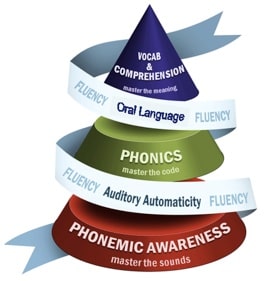The SpellRead program develops phonological automaticity in its students through rigorous phonemic and phonetic activities that allow students to listen, manipulate and process sounds, while connecting the relationships between sounds and letters. SpellRead creates a mastery of the sound system, giving students the most efficient method with which to read and decode language. Application of these skills to reading fluency creates efficiency in decoding text and allows for an ease of comprehension of properly leveled reading selections. Each class is completed by the practice of writing, where skills learned in every class are applied to the written word. SpellRead bridges the sound system to written and oral language, making reading easier and more efficient for every student.
The SpellRead Program
SpellRead is based on specific skill mastery, beginning with developing auditory processing skills, phonological and phonemic awareness, and the ability to manipulate the sounds of the English language with ease. Once students gain a base knowledge and sound system, higher level concepts are introduced, practiced, and mastered.
 Phase A provides the foundation for learning through training the auditory processing function of the brain to hear and manipulate the 44 sounds of the English language so that students develop a “sound processing reflex.” Students become able to automatically recognize each sound directly, without the need for associations to real words or rules which hinder automaticity.
Phase A provides the foundation for learning through training the auditory processing function of the brain to hear and manipulate the 44 sounds of the English language so that students develop a “sound processing reflex.” Students become able to automatically recognize each sound directly, without the need for associations to real words or rules which hinder automaticity.
 Phase B builds on the foundation learning of Phase A. It begins by introducing consonant blends, secondary vowel spellings and syllabication, moving students from the one-syllable level to the two to three syllable level. The connection built between the sound system and automaticity of the audio and visual connection creates solid growth in word decoding and vocabulary recognition.
Phase B builds on the foundation learning of Phase A. It begins by introducing consonant blends, secondary vowel spellings and syllabication, moving students from the one-syllable level to the two to three syllable level. The connection built between the sound system and automaticity of the audio and visual connection creates solid growth in word decoding and vocabulary recognition.
 Phase C continues to develop word recognition and ability with multi-syllabic words as ‘clusters,’ or common word endings (such as /tion/ in imagination and /tious/ in cautious) are introduced. As students progress their decoding skills and word recognition, steps are made to poly-syllabic words containing three to six syllables, that students learn to easily decode. Development of vocabulary pronunciation and verb forms are also introduced as students continue to enhance their skills learned in Phases A and B.
Phase C continues to develop word recognition and ability with multi-syllabic words as ‘clusters,’ or common word endings (such as /tion/ in imagination and /tious/ in cautious) are introduced. As students progress their decoding skills and word recognition, steps are made to poly-syllabic words containing three to six syllables, that students learn to easily decode. Development of vocabulary pronunciation and verb forms are also introduced as students continue to enhance their skills learned in Phases A and B.
Success at each phase of the SpellRead program is dependent on mastery of the preceding concepts. As students’ word-level skills, fluency, automaticity, vocabulary, and comprehension develop, the content, progression and complexity of reading instruction advances. As decoding skills grow, and word-reading becomes efficient through being automatic or a reflex, vocabulary, background knowledge, and language skills progress.